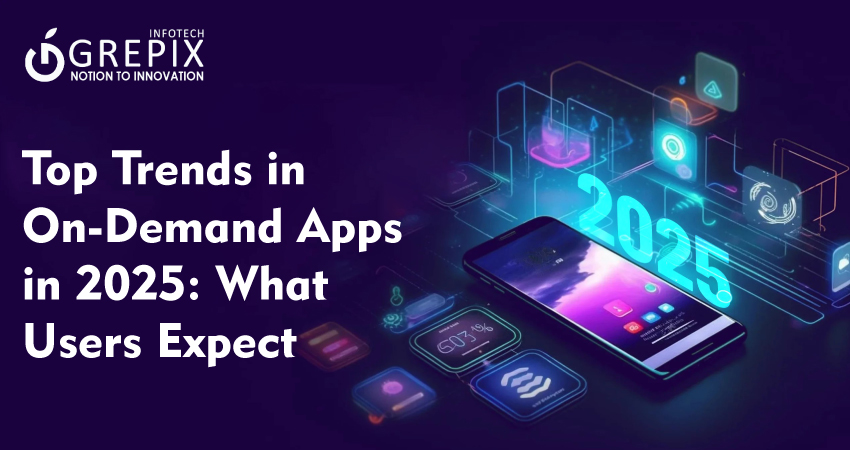Top Trends in On-Demand Apps in 2025: What Users Expect
The New Era of On-Demand Apps
The on-demand revolution started with simple ideas—tap a button, get a ride or order food. Fast-forward to 2025, and the landscape is unrecognizable. On-demand apps are now ecosystems of convenience—covering mobility, shopping, healthcare, logistics, and even finance.
At the center of this shift lies taxi app development. From Uber clone solutions to fully customized ride-hailing apps, businesses worldwide are innovating to keep up with rising consumer demands. Today’s users expect instant access, personalized services, transparency, and sustainability.
Let’s explore the top on-demand app trends in 2025 and break down what users expect when they open their favorite apps.
The on-demand economy is no longer a novelty—it has become a daily essential. From ride-hailing to food delivery, from logistics to healthcare, users now expect convenience at their fingertips. In 2025, on-demand apps are evolving rapidly with new technologies, user-first experiences, and sustainable solutions. Consumers are demanding faster services, secure in-app payments, eco-friendly mobility options, and personalized recommendations. Businesses are racing to keep up, turning to white-label taxi app development and Uber clone solutions to speed up launches while reducing costs.This blog dives deep into the top trends shaping on-demand apps in 2025—from ride-hailing app features to AI-driven personalization and blockchain-based security. Whether you’re building a taxi booking app, a delivery platform, or a super app, these insights will help you meet user expectations, scale faster, and stay competitive in an ever-changing market.
Top Trends Shaping On-Demand Apps in 2025
1 AI-Powered Personalization
AI has become the beating heart of modern on-demand apps.
Smarter Recommendations
Apps now predict user behavior, suggesting preferred drivers, favorite restaurants, or even ride-sharing with past travel companions.
Dynamic Pricing Models
AI dynamically adjusts fares, ensuring users get fair pricing while drivers maximize earnings.
Predictive Demand Planning
Taxi booking apps use AI to position drivers in high-demand zones before users even open the app.
Key takeaway: Personalization ensures loyalty. Users feel apps “know them,” increasing retention.
2 Seamless In-App Payments
Payment is no longer a backend process—it’s a core user experience.
Multi-Wallet Support
Users expect apps to support UPI, cards, wallets, net banking, and even cryptocurrencies.
One-Click Checkout
Faster checkout prevents cart or ride-booking abandonment.
Subscription Models
Many taxi apps now provide ride passes with discounted fares for frequent users.
in-app payments for taxi apps are now the backbone of smooth customer journeys.
3 Safety and Trust Features
Safety is not just a feature—it’s a dealbreaker.
SOS & Emergency Alerts
Real-time SOS buttons with live location sharing provide riders peace of mind.
Verified Drivers
AI-driven KYC ensures riders travel only with verified drivers.
Gender Preferences
Options like female driver requests are popular in global ride-hailing markets.
Key takeaway: Trust equals retention. Without safety, users uninstall.
4 Eco-Friendly and Sustainable Rides
Sustainability is no longer a niche—it’s mainstream.
- Electric vehicles (EVs) are becoming standard in taxi fleets.
- Apps promote ride-pooling to reduce emissions.
- Carbon-offset programs give eco-conscious riders greener choices.
Taxi app development in 2025 is green-first.
5 Hyperlocal On-Demand Services
Consumers want ultra-fast services, often within minutes.
- Quick commerce is booming with 10–30-minute deliveries.
- Geo-fenced promotions help businesses run localized offers.
- Apps leverage community couriers for nearby logistics.
6 Advanced Ride-Hailing App Features
The Uber clone no longer cuts it—users demand more.
- In-app chat & VoIP calling for rider-driver communication.
- Street pickup & multiple stops for convenience.
- Outstation trips & rentals for flexibility.
- Toll & tax integrations for transparent pricing.
Ride-hailing app features are more robust than ever.
7 Voice and Chatbot Integration
Voice assistants and chatbots make apps smarter.
- Voice booking via Alexa, Siri, and Google Assistant.
- AI chatbots manage support queries instantly.
- Multilingual support opens global markets.
8 White-Label Taxi App Development
Startups are choosing white-label Uber clone apps to launch fast.
Speed:
2–6 weeks vs 12–18 weeks for custom apps.
Cost:
Affordable vs high-cost custom builds.
Scalability:
Built-in for future expansion.
White-label apps lower risk and speed up success.
Also Read: "Fleet Management Apps: Essential Tools for Logistics Companies"
9 Cross-Vertical Super Apps
The super app wave continues in 2025.
- One app combines rides, payments, shopping, and food delivery.
- Inspired by Grab, Gojek, and Careem.
- Users enjoy all-in-one convenience.
10 Blockchain and Data Security
Security is non-negotiable in fintech-enabled on-demand apps.
- Blockchain ensures tamper-proof transactions.
- Fraud detection algorithms stop fake bookings.
- Data encryption builds customer trust.
11 Immersive UX with AR/VR
AR and VR are enhancing mobility.
- AR navigation helps drivers in congested cities.
- Virtual pickup zones simplify airports and malls.
- VR previews for travel and hospitality bookings.
12 Integration with Smart Mobility
The rise of smart mobility ecosystems is undeniable.
- Apps integrate with EV charging stations.
- E-scooters and bike rentals are now part of ride-hailing apps.
- AI-powered route planning saves fuel and time.
What Users Expect from On-Demand Apps in 2025
- Faster and reliable services
- Transparent pricing with no hidden charges
- Safety and trust-driven features
- Personalized offers and recommendations
- Eco-friendly choices
- Multi-platform access across web, mobile, and voice
Key Industries Driving On-Demand App Growth
Taxi Booking Apps
Taxi app development is evolving with AI, real-time tracking, SOS features, and digital payments.
Food Delivery & Grocery Apps
Consumers expect quick commerce, seamless re-ordering, and multiple payment options.
Logistics & Courier Apps
On-demand courier services thrive with real-time tracking, route optimization, and flexible scheduling.
Healthcare & Wellness Apps
Healthcare on-demand apps integrate video consultations, medicine delivery, and fitness coaching.
Super Apps & Multi-Service Platforms
Super apps dominate by offering mobility, payments, shopping, and social networking under one roof.
Conclusion
The on-demand app industry in 2025 is more dynamic than ever. Users expect speed, personalization, trust, and sustainability. Taxi booking apps, food delivery apps, and logistics solutions are no longer competing on convenience alone they are competing on experience and innovation.
For startups, Uber clone solutions and white-label taxi app development provide the fastest way to enter the market. For established businesses, advanced ride-hailing app features, AI-powered personalization, and cross-vertical integrations are crucial for long-term growth.
At Grepix, we help businesses launch and scale by offering customized, scalable on-demand app development solutions. From secure in-app payments to eco-friendly fleet integration, our platforms are built to meet the future of user demand.
The lesson is clear: the winners in 2025 will be businesses that not only innovate but also align with what users truly expect. Convenience, trust, personalization, and sustainability are no longer trends—they are essentials.
FAQs
1. What are the top features users expect in taxi booking apps in 2025?
Users want real-time tracking, SOS alerts, multi-stop rides, in-app wallets, and eco-friendly vehicle options.
2. How do in-app payments for taxi apps improve user experience?
They allow faster checkouts with cards, wallets, UPI, and even cryptocurrency, improving reliability and safety.
3. Why are Uber clone apps popular among startups?
They reduce cost and development time, allowing startups to launch within weeks.
4. What role does AI play in ride-hailing app development?
AI powers dynamic pricing, route optimization, fraud detection, and personalized recommendations.
5. How are on-demand apps becoming eco-friendly?
By integrating EV fleets, supporting ride-pooling, and adding carbon-offset features.







